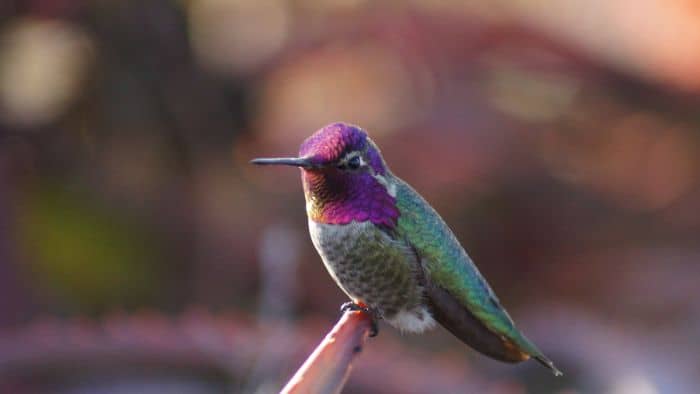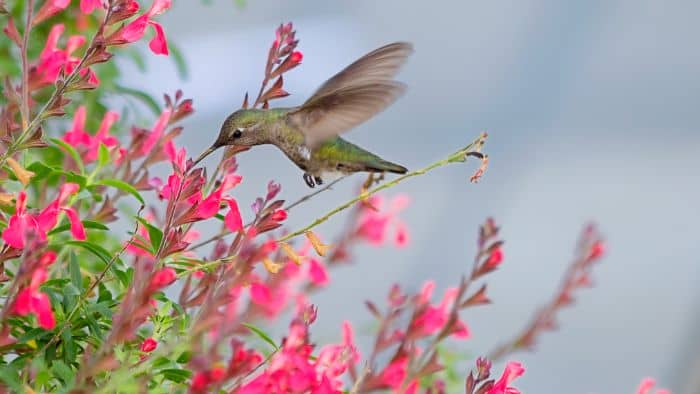Want to know more about the best trees for hummingbirds? Take a look at this article.
If you ever had a chance to see these little birdies in real life, we believe it was amazing. But if you want to see them even closer, you will need to a have garden full of red, orange, and purple colors. Hummingbirds love flowers, so one way to attract them is to have a garden where plants are always blooming.
These tiny birds are also special for many reasons. They can see and hear better than humans. They are able to see ultraviolet light and have no sense of smell at all (or very little).
Regardless of whether they are passing by or resting, if they see that there are red feeders and flowers in your garden, they will not be able to resist. Red is their favorite color, so you can use it to have several feathered tenants in your green space for a few months.
So if you are curious about the best trees for hummingbirds, read on!
What Trees Are Best To Attract Hummingbirds?
Hummingbirds are most attracted to red color and red flowers, but the truth is, these little birds are drawn to other bright colored flowers such as orange, yellow, purple, and pink.
We will share with you several types of trees that will attract hummingbirds the most.
Crabapple trees (Malus spp) are absolutely gorgeous even more when they explode with stunning white, red and pink flowers in the spring. Flowers shed in summer and glossy green foliage lasts all year around.

Next is, Horse Chestnut (Aesculus Hippocastanum). Mature horse chestnut trees are about 40 m tall and have a lifespan of about 300 years. The bark is smooth and pinkish-grey when young, darkening with age and forming scaly plates. The twigs are hairless and tough. The buds are oval, dark red, glossy, and sticky. Horse chestnuts produce tall, upright white flowers every spring.
Northern Catalpa (Catalpa Speciosa) has large clusters of flowers that resemble orchids. Other notable features include leaves that are one foot long and bean-like fruits that can grow nearly two feet long. Northern catalpa is widely grown in residential areas, parks, and other open spaces, thanks to its rapid growth, dense shade, and excellent tolerance to urban conditions.
Further, we have Eastern Redbud (Cercis Canadensis). It is one of the earliest plants to bloom each year, covering the branches with tiny pink flowers, but their beauty extends far beyond the spring season. In summer, the fading flowers turn from heart-shaped green to bronze leaves and brown pods remain on the tree long after the leaves have fallen. A unique variety is called ‘Forest Pansy’ and produces purple leaves. Western redbud may also attract hummingbirds.
Where Does A Hummingbird Nest?
Now that you know which are the “best trees for hummingbirds”, it’s time to answer to some other questions.
While every bird’s nest is a testament to nature’s amazing artistry, there is something almost magical about hummingbird nests. These tiny birds are found only in America, but the majority of the approximately 330 species do not migrate further north than Central and South America.
Although the specifics vary by hummingbird species, hummingbirds typically build nests in trees or dense brush, which provides protection for the mother and her young from predators. You will usually find hummingbird nests 5 to 10 meters off the ground- even up to 90 meters above the ground- nestled in the branches of small trees or shrubs.
Hummingbird nests are soft and cozy havens for their eggs and young birds, unlike many other birds nests that build a fairly rigid structure of woven branches. To achieve the desired level of comfort, strength, and elasticity in the finished nest, female hummingbirds seek out materials that can be tied securely. Common materials that can be used are: small pieces of bark, leaves especially those with moss and lichens, cotton fiber, spider web, pod flakes, and more.
What Is A Hummingbird’s Favorite Bush?
Now that you are familiar with the best trees for hummingbirds, we suggest saying a few sentences about bushes. What do you say, shall we? Ok, let’s go!
Hummingbirds are one of the most striking and beautiful birds. Scientists have been fascinated with their fast wings and ability to hover. But if you want to see one of them, you have to find out a few things they especially like.
Hummers love flowers and places that are colorful and cheerful, where plants are always blooming. Tubular flowers in bright colors that tend to produce the most nectar are especially attractive to hummingbirds. These include perennials such as daylilies, lupines, cleomes, impatiens, and petunias.
They love the Butterfly bush (Buddleia davidii) and its flowers because it has a high nectar count. Another advantage of bushes like these is that they are easy to spot, not only by hummingbirds but also butterflies. This plant is easy to grow and it requires little care.

Do Hummingbirds Like Certain Trees?
Hummingbirds seek out locations sheltered by protruding limbs, drooping branches, or deformed trunks. When choosing trees, bushes, or perennials, these little birds tend to choose those with red or pink flowers. White and often neutral colors are usually passed by because they aren’t bright enough to catch a hummingbird’s eye.
When hummingbirds are looking for trees to build their nests, they look for certain criteria rather than species. Nests are usually protected from the elements by foliage a few inches above the nest. Hummingbirds don’t like wind, so they prefer groups of trees that provide more shelter than single trees.
Also, they have a very fast metabolism, so they will prefer trees or plants that can provide them with nectar, insects, and plenty of water.
To Wrap Up
In conclusion, when we talk about the best trees for hummingbirds we need to consider the different flowering times of trees and shrubs that attract these little birdies. Selecting ones with varying times of bloom ensure hummingbirds will have nectar throughout the entire season.
It’s no secret that these birds really like trees that bloom in red and orange colors. Since these birds migrate when the cold period comes, they like to return to the colorful spring world.
Did you know all about the best trees for hummingbirds before reading this article? Let us know in the section below!
Read on: Flowers For Hummingbirds In California: 8 Extraordinary Species You Can’t Go Wrong With

